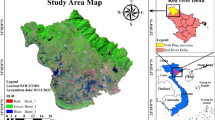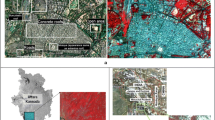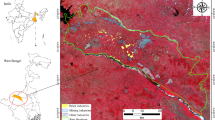Abstract
Spectral indices help in modeling, predicting, or infer surface processes. Indices are derived for many different combinations of satellite spectral bands. There are various applications of the satellite indices that are explored in the past studies includes agriculture, water resources, urban development, forest ecology, geology, soil sciences, vegetation, and other applications. In the literature, a few studies have been conducted majorly from the perspective to evaluate/compare/explore Landsat-8 OLI and Sentinel-2 images. Spectral, statistical, and the image analysis techniques have been used. However, there has not been any study focusing on Nava Raipur Atal Nagar, India till date. Not many studies have used GIS-based tools even though neither considered the spectral nor spatial consistency of Landsat-8 and Sentinel-2A data using criteria sets methodology performed as in this work. In the current research, the ensuing indices were derived: Normalized Difference Vegetation Index, Modified Normalized Difference Water Index, Soil Adjusted Vegetation Index, Normalized Difference Built-up Index, Bare Soil Index and Built-up Index. The comparative evaluation of the spectral and spatial consistency of Landsat-8 and Sentinel-2 and the correlation coefficients for each pair of indices are derived, and plotted the outcomes with scatter plots. In addition, linear model is compared with several alternative fitting curvilinear models such as Reciprocal-x, Square root-y reciprocal-x, Squared-y reciprocal-x, S-curve model, Squared-y logarithmic-x, Logarithmic-x, Squared-y square root-x, Square root-y logarithmic-x, Square root-x, Squared-y, Double reciprocal, Multiplicative, Double square root, Logarithmic-y square root-x, Square root-y, Double squared, Reciprocal-y logarithmic-x, Exponential, Squared-x, Reciprocal-y square root-x, Square root-y squared-x, Reciprocal-y, Logarithmic-y squared-x, Reciprocal-y squared-x, Logistic, and Log probit. The Modified Normalized Difference Water Index, Normalized Difference Built-up Index and Normalized Difference Vegetation Index indices have got the better correlation coefficients of 72.02%, 70%, and 69.81%, and Bare Soil Index takes the minimum at 54.4%. Outcomes establish a good correlation between derived satellite indices of Sentinel-2 and Landsat-8. Comparing this research to other research in the Indian region with satellite-based indices demonstrates that our model accuracies are significant although the difference between them is low. These data have multiple applications that are essential in sustainable development as much research are focusing attention on indices from multiple sensors and more research is underway. Present paper will come in handy for the initial evaluation for the sustainable development of an urban area.


Similar content being viewed by others
References
Abutaleb K, Freddy Mudede M, Nkongolo N, Newete S (2020) W, Estimating urban greenness index using remote sensing data: a case study of an affluent vs poor suburbs in the city of Johannesburg. Egypt J Remote Sens Space Sci. https://doi.org/10.1016/j.ejrs.2020.07.002
Adiri Z, Lhissou R, El Harti A, Jellouli A, Chakouri M (2020) Recent advances in the use of public domain satellite imagery for mineral exploration: a review of Landsat-8 and Sentinel-2 applications. Ore Geol Rev 117:1033332
Asadi A, Arefi H, Fathipoor H (2020) Simulation of green roofs and their potential mitigating effects on the Urban Heat Island using an artificial neural network: a case study in Austin, Texas. Adv Space Res. https://doi.org/10.1016/j.asr.2020.06.039
Astola H, Häme T, Sirro L, Molinier M, Kilpi J (2019) Comparison of Sentinel-2 and Landsat 8 imagery for forest variable prediction in boreal region. Remote Sens Environ 223:257–273
Chastain R, Housman I, Goldstein J, Finco M, Tenneson K (2019) Empirical cross sensor comparison of Sentinel-2A and 2B MSI, Landsat-8 OLI, and Landsat-7 ETM+ top of atmosphere spectral characteristics over the conterminous United States. Remote Sens Environ 221:274–285
Chen J, Zhu W, Tian YQ, Yu Q (2020) Monitoring dissolved organic carbon by combining Landsat-8 and Sentinel-2 satellites: case study in Saginaw River estuary, Lake Huron. Sci Total Environ 718:137374. https://doi.org/10.1016/j.scitotenv.2020.137374
Chen X, Jiang L, Zhang G, Meng L, Pan Z, Lun F, An P (2021) Green-depressing cropping system: a referential land use practice for fallow to ensure a harmonious human-land relationship in the farming-pastoral ecotone of northern China. Land Use Policy 100:10417
Claverie M, Junchang Ju, Masek JG, Dungan JL, Vermote EF, Roger J-C, Skakun SV, Justice C (2018) The Harmonized Landsat and Sentinel-2 surface reflectance data set. Remote Sens Environ 219:145–161
Davis E (2018) Comparison of Sentinel-2 and Landsat 8 OLI in the mapping of soil salinity in Hyde County, North Carolina (Master’s thesis). Retrieved from https://scholarcommons.sc.edu/etd/4870. Accessed 26 Mar 2020
Degife AW, Zabel F, Mauser W (2018) Assessing land use and land cover changes and agricultural farmland expansions in Gambella Region, Ethiopia, using Landsat 5 and Sentinel 2a multispectral data. Heliyon 4(11):e00919. https://doi.org/10.1016/j.heliyon.2018.e00919
Duplančić Leder T, Leder N, Baučić M (2020) Application of satellite imagery and water indices to the hydrography of the Cetina River Basin (Middle Adriatic). Trans Maritime Sci Split 9(2):374–384. https://doi.org/10.7225/toms.v09.n02.020
Flood N (2017) Comparing Sentinel-2A and Landsat 7 and 8 using surface reflectance over Australia. Remote Sens 9:659
Forkuor G, Dimobe K, Serme I, Tondoh JE (2017) Landsat-8 vs. Sentinel-2: examining the added value of sentinel-2’s red-edge bands to land-use and land-cover mapping in Burkina Faso. Gisci Remote Sens. https://doi.org/10.1080/15481603.2017.1370169
Gholizadeh A, Žižala D, Saberioon M, Borůvka L (2018) Soil organic carbon and texture retrieving and mapping using proximal, airborne and Sentinel-2 spectral imaging. Remote Sens Environ 218:89–103
Goldblatt R, Deininger K, Hanson G (2018) Utilizing publicly available satellite data for urban research: Mapping built-up land cover and land use in Ho Chi Minh City, Vietnam. Dev Eng 3:83–99. https://doi.org/10.1016/j.deveng.2018.03.001
Gorji T, Yildirim A, Hamzehpour N, Tanik A, Sertel E (2020) Soil salinity analysis of Urmia Lake Basin using Landsat-8 OLI and Sentinel-2A based spectral indices and electrical conductivity measurements. Ecol Ind 112:106173. https://doi.org/10.1016/j.ecolind.2020.106173
Huete AR (1998) A soil-adjusted vegetation index (SAVI). Remote Sens Environ 25:295–309
Kwang C, Jnr EM, Amoah AS (2018) Comparing of Landsat 8 and Sentinel 2A using water extraction indexes over Volta river. JGG 10(1):1
Lessio A, Fissore V, Borgogno Mondino E (2017) Preliminary tests and results concerning integration of sentinel-2 and Landsat-8 OLI for crop monitoring. J Imaging 3:9
Li P, Ke Y, Bai J, Zhang S, Chen M, Zhou D (2019) Spatiotemporal dynamics of suspended particulate matter in the Yellow River Estuary, China during the past two decades based on time-series Landsat and Sentinel-2 data. Mar Pollut Bull 149:110518. https://doi.org/10.1016/j.marpolbul.2019.110518
Li W, Niu Z, Shang R, Qin Y, Wang L, Chen H (2020) High-resolution mapping of forest canopy height using machine learning by coupling ICESat-2 LiDAR with Sentinel-1, Sentinel-2 and Landsat-8 data. Int J Appl Earth Obs Geoinf 92:102163. https://doi.org/10.1016/j.jag.2020.102163
Lima TA, Beuchle R, Langner A, Grecchi RC, Griess VC, Achard F (2019) Comparing Sentinel-2 MSI and Landsat 8 OLI imagery for monitoring selective logging in the Brazilian Amazon. Remote Sens 11(8):961. https://doi.org/10.3390/rs11080961
Mandanici E, Bitelli G (2016) Preliminary comparison of Sentinel-2 and Landsat 8 imagery for a combined use. Remote Sens 8:1014
Moore DS, Notz WI, Flinger MA (2013) The basic practice of statistics, 6th edn. W. H. Freeman and Company, New York
Naya Raipur Development Plan-2031 (2008) Naya Raipur Development Authority. Accessed 17 June 2008
Pandey D, Tiwari KC (2020) Extraction of urban built-up surfaces and its subclasses using existing built-up indices with separability analysis of spectrally mixed classes in AVIRIS-NG imagery. Adv Space Res. https://doi.org/10.1016/j.asr.2020.06.038
Paul S, Kumar DN (2019) Comparison of Landsat-8 and Sentinel-2 data for classification of Rabi crops over Karnataka, India. Int Arch Photogramm Remote Sens Spatial Inf Sci 36:579–584. https://doi.org/10.5194/isprs-archives-XLII-3-W6-579-2019
Pesaresi M, Corbane C, Julea A, Florczyk A, Syrris V, Soille P (2016) Assessment of the added-value of Sentinel-2 for detecting built-up areas. Remote Sens 8:299
Piyoosh AK, Ghosh SK (2018) Development of a modified bare soil and urban index for Landsat 8 satellite data. Geocarto Int 33(4):423–442
Prasad AD, Ganasala P (2020) Preliminary assessment of remote sensing satellite data and spectral indices for sustainable development of a smart city. 2020 International Conference on Advances in Computing, Communication & Materials (ICACCM): 212–214. https://doi.org/10.1109/ICACCM50413.2020.9212894
Prasomsup W, Piyatadsananon P, Aunphoklang W, Boonrang A (2020) Extraction technic for built-up area classification in Landsat 8 imagery”. IJESD 11(1):15
Rouse JW, Haas RH, Schell JA, Deering DW (1973) Monitoring the vernal advancement and retrogradation (green wave effect) of natural vegetation. Progress Report RSC 1978–1:112
Rujoiu-Mare M-R, Mihai B-A (2016) Mapping land cover using remote sensing data and GIS techniques: a case study of Prahova Subcarpathians. Procedia Environ Sci 32:244–255. https://doi.org/10.1016/j.proenv.2016.03.029
Runge A, Grosse G (2019) Comparing spectral characteristics of Landsat-8 and Sentinel-2 same-day data for Arctic-Boreal Regions. Remote Sensing 11(14):1730. https://doi.org/10.3390/rs11141730
Sánchez-Espinosa A, Schröder C (2019) Land use and land cover mapping in wetlands one step closer to the ground: Sentinel-2 versus landsat 8. J Environ Manage 247:484–498. https://doi.org/10.1016/j.jenvman.2019.06.084
Singh Rawat K, Kumar Singh S, Kumar Pal R (2019) Synergetic methodology for estimation of soil moisture over agricultural area using Landsat-8 and Sentinel-1 satellite data. Remote Sens Appl 15:100250. https://doi.org/10.1016/j.rsase.2019.100250
Skakun S, Vermote E, Roger JC, Franch B (2017) Combined use of Landsat-8 and Sentinel-2A images for winter crop mapping and winter wheat yield assessment at regional scale. AIMS Geosci 3:163–186
Trinh RC, Fichot CG, Gierach MM, Holt B, Malakar NK, Hulley G, Smith J (2017) Application of Landsat 8 for monitoring impacts of wastewater discharge on coastal water quality. Front Mar Sci 4:329
Van der Werff H, van der Meer F (2015) Sentinel-2 for mapping iron absorption feature parameters. Remote Sens 7:12635–12653
Watson CS, King O, Miles ES, Quincey DJ (2018) Optimising NDWI supraglacial pond classification on Himalayan debriscovered glaciers. Remote Sens Environ 217:414–425
Wohlfart C, Mack B, Liu G, Kuenzer C (2017) Multi-faceted land cover and land use change analyses in the Yellow River Basin based on dense Landsat time series: exemplary analysis in mining, agriculture, forest, and urban areas. Appl Geogr 85:73–88. https://doi.org/10.1016/j.apgeog.2017.06.004
Xian G, Shi H, Dewitz J, Wu Z (2019) Performances of WorldView 3, Sentinel 2, and Landsat 8 data in mapping impervious surface. Remote Sens Appl 15:100246. https://doi.org/10.1016/j.rsase.2019.100246
Xu H (2006) Modification of normalised difference water index (NDWI) to enhance open water features in remotely sensed imagery. Int J Remote Sens 27:3025–3033
Yang D, Chen J, Zhou Y, Chen X, Chen X, Cao X (2017) Mapping plastic greenhouse with medium spatial resolution satellite data: development of a new spectral index. ISPRS J Photogramm Remote Sens 128:47–60. https://doi.org/10.1016/j.isprsjprs.2017.03.002
Yang X, Qin Q, Grussenmeyer P, Koehl M (2018) Urban surface water body detection with suppressed built-up noise based on water indices from Sentinel-2 MSI imagery. Remote Sens Environ 219:259–270
Yusof N, Shafri HZM, Shaharum NSN (2021) The use of Landsat-8 and Sentinel-2 imageries in detecting and mapping rubber trees. J Rubber Res 24:121–135. https://doi.org/10.1007/s42464-020-00078-0
Zha Y, Gao J, Ni S (2003) Use of normalized difference built-up index in automatically mapping urban areas from TM imagery. Int J Remote Sens 24(3):583–594
Zhang HK, Roy DP, Yan L, Li Z, Huang H, Vermote E, Skakun S, Roger J-C (2018) Characterization of Sentinel-2A and Landsat-8 top of atmosphere, surface, and nadir BRDF adjusted reflectance and NDVI differences. Remote Sens Environ 215:482–494
Acknowledgements
The authors are thankful to the Copernicus and USGS for providing data free of cost. In addition, the authors are grateful to the anonymous reviewers for their constructive comments that lead to improvement of the initial manuscript in the present form.
Funding
No funding was received for this work.
Author information
Authors and Affiliations
Corresponding author
Ethics declarations
Conflict of interest
No conflict of interest exists. We wish to confirm that there are no known conflicts of interest associated with this publication and there has been no significant financial support for this work that could have influenced its outcome.
Intellectual property
We confirm that we have given due consideration to the protection of intellectual property associated with this work and that there are no impediments to publication, including the timing of publication, with respect to intellectual property. In doing so, we confirm that we have followed the regulations of our institutions concerning intellectual property. We confirm that the manuscript has been read and approved by all the named authors. We confirm that the order of authors listed in the manuscript has been approved by all the named authors.
Additional information
Publisher's Note
Springer Nature remains neutral with regard to jurisdictional claims in published maps and institutional affiliations.
Rights and permissions
About this article
Cite this article
Prasad, A.D., Ganasala, P., Hernández-Guzmán, R. et al. Remote sensing satellite data and spectral indices: an initial evaluation for the sustainable development of an urban area. Sustain. Water Resour. Manag. 8, 19 (2022). https://doi.org/10.1007/s40899-022-00607-2
Received:
Accepted:
Published:
DOI: https://doi.org/10.1007/s40899-022-00607-2





